Bartolo’s Sacred Narrative
The Museum of Biblical Art in New York has mounted a remarkable exhibition with Bartolo di Fredi’s 14th century masterpiece, Adoration of the Magi. This small but powerful exhibition, but one of many in the 7-year history of MOBIA, is an exploration of exactly how a “painter of faith” narrates adoration. MOBIA is the only scholarly museum celebrating art and the Bible in the United States and, while has major support from the American Bible Society, is fully independent of any denomination or religion.
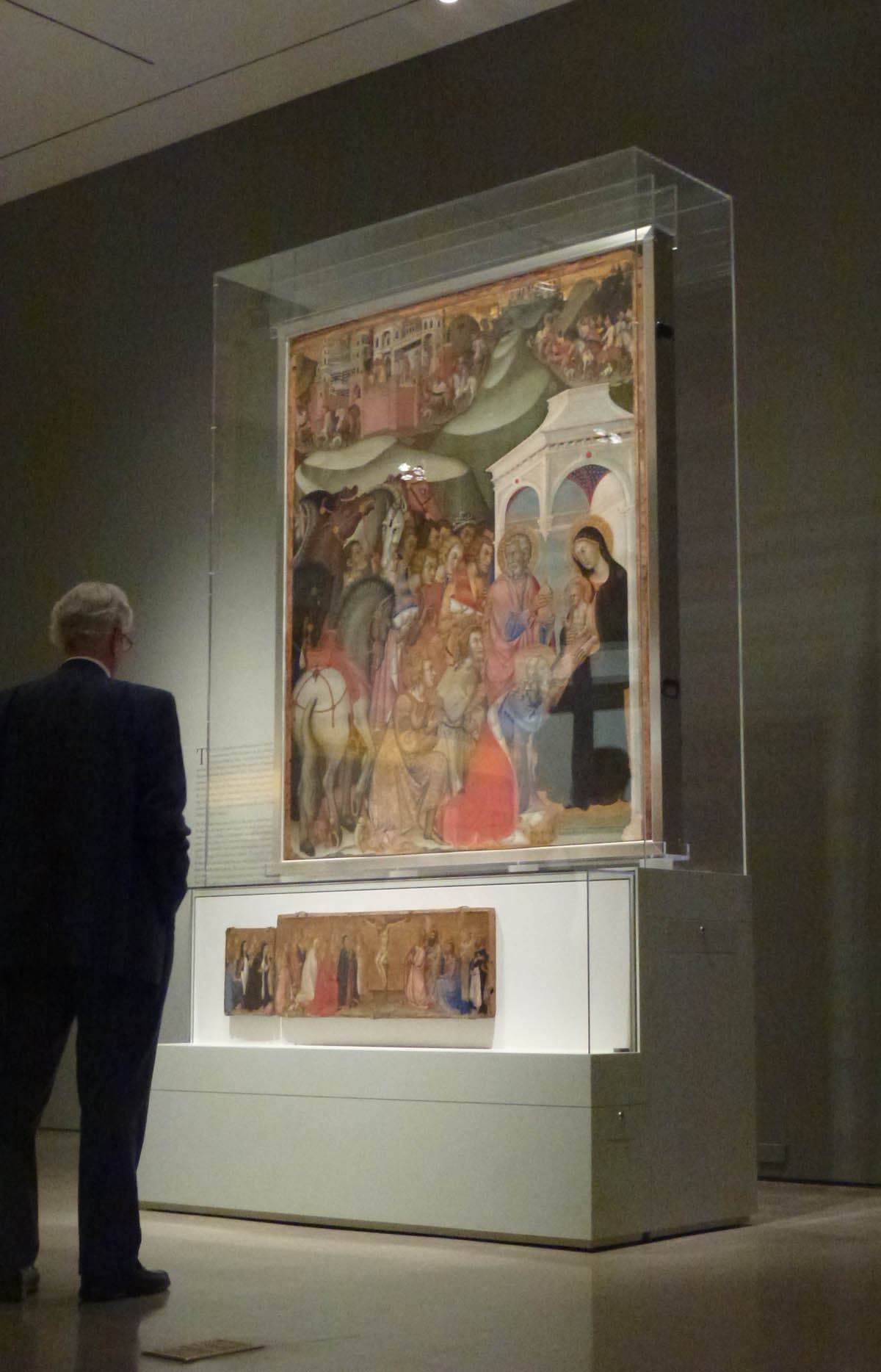
This is reflected by the distinctly non-seasonal exhibition dates that were dictated by pre-existing schedules and artwork availability. Nonetheless, the show had to be seen.
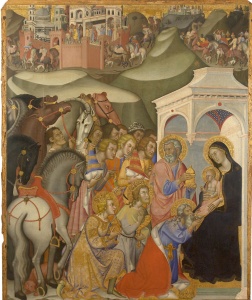
The star “Adoration” of the show was created sometime between 1375 and 1385 for the altar of the Magi in the church of San Domenico in Siena and is a celebration of the Virgin for the “city of the Virgin.” It remained there for 400 years until it was unceremoniously removed and dismembered into four pieces. The main panel containing the image of the Adoration of the Magi was placed in the newly created Pinacoteca Nazionale of Siena while the predella was divided into three sections; one (Saints and Crucifixion) finding its way to the Lindenau-Museum of Altenburg, Germany, the other (Saints in Adoration) to the University of Virginia Art Museum and the third now presumably lost. They are now reunited for the first time in this exhibition; a triumph for two visionary museum directors, Ena Heller of MOBIA and Bruce Boucher of University of Virginia Art Museum who garnered substantial support and collaboration from the Italian and Sienese cultural authorities and the Lindenau-Museum.
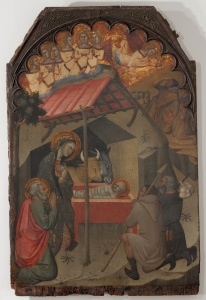
Additionally seen here are two other relevant works by Bartolo di Fredi (1330-1410); an earlier Adoration of the Shepherds (1374) from the Cloisters and a slightly later Adoration of the Magi (1390) from the Lehman Collection. But when all is said and done, the narrative hinges on Joseph, the hapless husband of the Virgin Mary. And significantly Bartolo may be the first artist to insert Joseph in the Adoration of the Magi.
The Virgin was the patron saint and protector of Siena and many different depictions were all common in the 14th century including; Enthronement with the infant Jesus, i.e. the iconic Maesta, Celestial coronation by Jesus, the venerated Virgin and Child as well as Misericordia (Madonna of Mercy). However the narrative of adoration is uniquely found in scripture. Luke 2:8-20 reports that an angelic vision appeared to shepherds announcing the birth of the Savior in Bethlehem. They rushed there to see the newborn babe and related their heavenly vision. This is the source of Bartolo’s Adoration of the Shepherds that expands the biblical narrative to include adoration by the shepherds, Mary and Joseph and a cow and a donkey. Bartolo crowns the painting with seven angels appearing to the shepherds while below Mary is mesmerized by the swaddled infant. Pointedly Joseph, seen in stiff profile, is kneeling outside the primitive roofed enclosure.
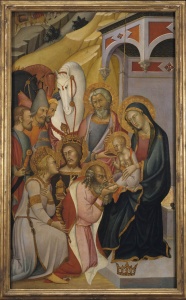
The subject of adoration significantly shifts in the Adoration of the Magi from the Lehman Collection of 1390. Here the text is from Matthew 2:1-11 and engages the historical narrative, weaving the story of the wise men (or astrologers) sighting a star that confirms the birth of the king of the Jews and their encounter with King Herod in Jerusalem. They then continue to follow the star, locate the newborn, worship him and present gifts of “gold, frankincense and myrrh.” This adoration is a much more formal affair, with the magi transformed in later Christian tradition into three kings (to match the 3 gifts) and arriving with an entourage of servants and horses. The three kings reflect the three ages of man, each bearing gifts with portentous significance: the gold represents kingship, incense evokes divinity and myrrh the Passion. Two of the kings wear crowns while the eldest is kneeling and tenderly kissing the Christ child’s feet, his crown humbly removed and placed at the feet of the Virgin. It is a ritualistic, somber depiction with Joseph in the center anchoring the composition, alone gazing out at the viewer in contemplation.
The massive Adoration of the Magi altarpiece from Siena presents a dramatically different narrative depiction of adoration. The upper third of the painting elaborates on the riotous precession of the Magi accompanied by servants, horses, camels and monkeys towards Jerusalem, here conflated with Siena to express the popular belief that indeed Siena had become as important as the Holy City, a hub of trade and religiosity. The famous marble striped cathedral, still under construction at the time, is prominently seen in the upper left within the city walls. The procession, proceeding right to left, finally enters the city gate and, after conferring with Herod and a court of elders, exits at the extreme upper left of the painting. We next see them in the immediate foreground, creating the impression that they have swung around to re-enter the painting in a rush of horses, camels, servants and riff-raff. The three kings kneel and offer obeisance with unquestioning devotion. Two servants in the middle of the composition hold the elaborate pointed hats of the Magi, now removed to accommodate the king’s crowns. The theme of wise men / astrologers transformed into royalty is a central motif evoking Gentile recognition of the infant Messiah. But all is not well in the devotional sweep to the Virgin and her son. The horses are out of control, stomping, neighing and baring their teeth. The leering crowd does not understand the import of this miracle. And it is Joseph’s stark glance to the left, directly at the raucous animals and mob that reveals the fact that the Savior is not recognized by all and much struggle will lie ahead. Bartolo has transformed a devotional painting into a dramatic and tension filled narrative.
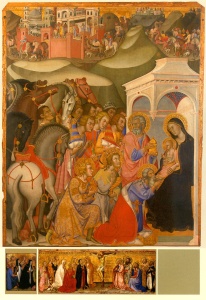
His insight is further reflected in the newly united predella of adoring saints, male and female, surrounding the apparition of a mystical crucifixion. Here, closest to the eyes of the faithful, is a veritable lexicon of saints with their gruesome symbols of martyrdom. Derived from the 13th century Golden Legend, the saints include Dominican-clad individuals bringing the message of faith into contemporary 14th century consciousness. The predella testifies to a faith that was tragically absent in the adoration depicted above.
Bartolo di Fredi’s Siena was an anvil of Christian faith, battered by the Black Death of 1348, haunted by Dominican preachers, Catherine of Siena’s depredations and the awesome challenge of his artistic predecessors: Pisano, Duccio, Martini, and Lorenzetti. The MOBIA exhibition brilliantly maps the development of the adoration narrative in the hands of Bartolo di Fredi, a rare museum focus on one artist and one subject in Trecento Italy.
Museum of Biblical Art
1865 Broadway at 61st Street, New York, N.Y.
212 408 1500 – www.mobia.org